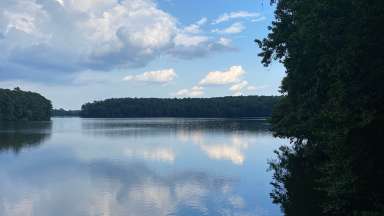Jump To:
Did you know - all lakes in Raleigh are man-made? They were built to manage how water flows through the city when it rains. Lakes help control flood risk and provide a good ecosystem for wildlife. Water can also be stored for:
- Mills;
- Agriculture;
- Drinking water supply; and,
- Recreation.
Our Goal
The main focus of the Lake Management Evaluation Program Policy is to protect the community and environment with a variety of lake options. View the policy (PDF).
There are more than 100 lakes in Raleigh. We will be assessing them for their stormwater and environmental benefits. Lake assessments will take place during watershed studies and other projects.
Our Priorities
When we are working on a lake-specific project, we take into account several factors like:
- Public safety
- Reducing flood risk
- Protecting waterways
- Benefit to the entire watershed
- Regulatory compliance
Project phases include planning, analysis, design, construction, and maintenance.
Lake Management Options
Based on our findings during a project, we will identify the most effective way(s) to manage a lake. Solutions will vary based on location and needs. This process involves discussions with the community, the Stormwater Management Advisory Commission (SMAC), and Raleigh City Council.
| Options | Results |
|---|---|
| Lake Preservation | Keeping the shape of the lake the same with upgrades to spillways that carry water out of a lake. Other upgrades include the embankment (or foundation) of a dam that holds in water. |
| Stream Restoration | Restoring a lake to a natural stream that helps water flow downstream. |
| Wetland | Converting the lake to a man-made wetland. This improves water quality and wildlife habitat. This is an example of a 'closer-to-source control' that stores and cleans water directly on a site to reduce pollution. |
